Productivity
Peer Recognition: Overcoming Challenges & Favoritism

Peer recognition is an important aspect of workplace culture as it fosters a positive and inclusive environment, boosts employee morale, and reinforces desired behaviors. When peers recognize each other, it can lead to stronger teamwork and improved relationships between colleagues. A study by the Society for Human Resource Management found that companies with formal peer recognition programs saw a boost in employee morale, job satisfaction, and organizational commitment.
Peer recognition has shown an increase in employee engagement by up to 50%
However, not all companies implement peer recognition effectively. To begin with, the peer recognition program should align with the company’s values and culture. For example, if the company values teamwork, then the recognition program should focus on rewarding teamwork and collaboration. Furthermore, peer recognition should be consistent and fair, ensuring that all employees have equal opportunities to receive recognition. This means that the program should not be biased toward certain employees or departments. Here’s where most organizations, despite having a good peer recognition program, fail to implement and execute.
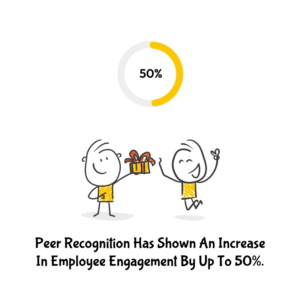
We must understand that peer recognition program implementation can face challenges in different industries due to unique work environments and cultural differences. Here are some of the common challenges faced by different industries:
- Healthcare: In healthcare, employees often work long hours and face high levels of stress. This can make it challenging to find the time and energy to recognize their peers, as well as creating a culture of recognition.
- Manufacturing: In manufacturing, there is often a large number of employees on the production line, making it difficult to single out individuals for recognition. Additionally, production lines are often fast-paced, making it challenging to take the time to recognize peers.
- Retail: Retail employees often work in a customer-focused environment. This can make it difficult to recognize peers for their contributions, as the focus is often on providing excellent customer service.
- Technology: The technology industry is rapidly evolving, and employees are often working on cutting-edge projects. This can make it challenging to find the time and resources to implement a robust peer recognition program, as employees are focused on delivering results.
- Finance: In the world of finance, employees are often too focussed on numbers and strict deadlines. In an intensely competitive environment, individuals end up calculating the recognition they ought to give, and every word of praise is quantified.
- Government Agencies: Government agencies often have strict regulations and policies in place, which can make it challenging to implement a peer recognition program. Additionally, government agencies often have a hierarchical structure, making it difficult to encourage peer recognition among employees.
By identifying the challenges specific to your industry, you can work towards creating an effective and appropriate peer recognition program. Once that is done, you’re faced with the hurdle of weeding out favoritism from peer recognition. We realize that peer recognition is a powerful tool for boosting employee morale and motivation. However, if not implemented properly, it can quickly become a source of frustration and resentment among employees. One of the most common concerns with peer recognition programs is that they may foster a culture of favoritism, where certain employees receive recognition more frequently or receive more lavish rewards. This can not only demoralize other employees but can also damage the integrity of the recognition program itself. Here are some steps you can take to ensure that your peer recognition program is free from favoritism:
Establish clear criteria for recognition:
Specify the behaviors, achievements, or qualities that are being recognized and ensure that they are communicated to all employees. This will help ensure that everyone is aware of what they need to do to earn recognition and eliminate subjective interpretations of what is deserving of recognition.
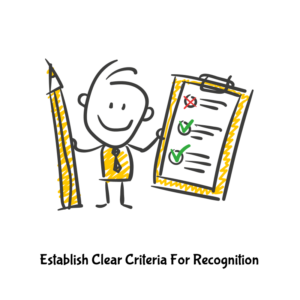
Make the process transparent:
Use a system, such as an online recognition platform, that allows for recognition to be given publicly. This helps to prevent one person or group from dominating the recognition process.
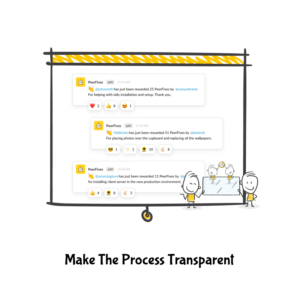
Encourage diverse recognition:
Encourage employees to recognize their peers from a variety of departments, teams, and backgrounds. This will help ensure that recognition is distributed fairly and that employees are recognized for their achievements rather than their personal relationships.

Monitor recognition patterns:
Regularly review the recognition data to identify any patterns or biases. If you identify any issues, take steps to address them and communicate the changes to all employees.
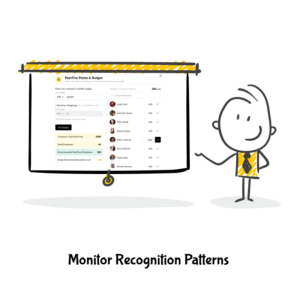
Celebrate all achievements:
Make sure that all recognized achievements are celebrated and communicated to the entire organization. This helps to ensure that everyone feels valued and that the recognition program is not seen as exclusive or biased.

In conclusion, different industries face unique challenges with respect to peer recognition and favoritism within the system, but these can be overcome with careful planning and a commitment to creating a culture of recognition. A peer recognition tool can simplify the peer recognition process by automating and streamlining various tasks.
PeerFives aims to provide its users with exactly the features they require, right from tracking and reporting on the recognition received by each employee to provide valuable insights into the success of the program.
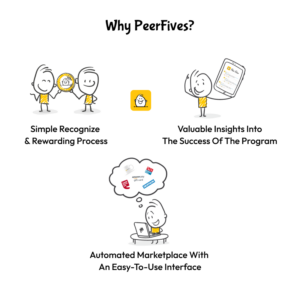
Its also helps manage rewards and redemption, such as gift cards or merchandise. This is done via an automated marketplace with an easy-to-use interface.
PeerFives meets the specific needs of every organization, helping employees seamlessly align with company values and reflect the core values of the organization while recognizing good work.
Ultimately, PeerFives is your one-stop solution to overcome all peer recognition-related challenges while eliminating any kind of favoritism within the organization that has the potential to derail a well-designed peer recognition program. Get started now with PeerFives’ FREE 30-day trial and feel the difference.
